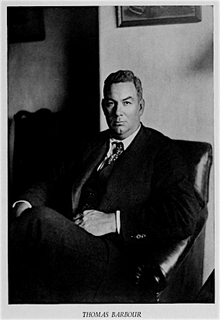Thomas Barbour
Thomas Barbour (born August 19, 1884 on Martha's Vineyard , † January 8, 1946 in Boston ) was an American herpetologist .
Live and act
Barbour was the eldest of four sons of Colonel William Barbour and his wife Julia Adelaide Sprague. Barbour's father was the founder and president of the Linen Thread Company, Inc., a successful yarn manufacturer with multiple offices in the US, Ireland and Scotland. Thomas Barbour grew up in Monmouth County , New Jersey , where one of his younger brothers, William Warren Barbour, embarked on a political career and served as a US Senator from 1931 to 1937 and again from 1938 to 1943 . At the age of 15, Thomas Barbour first visited the Museum of Comparative Zoology at Harvard University , where he later studied zoology under Alexander Agassiz , son of Louis Agassiz . After completing his Bachelor of Arts , Master of Arts (1908) and Ph.D. (1911) he worked at the Museum of Comparative Zoology, where he succeeded Samuel Garman as curator in the department for reptiles and amphibians. In 1916 he was elected to the American Academy of Arts and Sciences , in 1933 to the National Academy of Sciences and in 1937 to the American Philosophical Society . Eventually Barbour became professor of zoology and ran the museum as director between 1927 and 1946. Although he devoted most of his research to amphibians and reptiles, he also studied birds and insects, especially butterflies.
Barbour's scientific expeditions took him to Africa, Asia, North America, Central America, South America and the Caribbean. He was particularly impressed by the countries Panama , Costa Rica and Cuba, which he visited at least 30 times from 1908 onwards. From 1927 until his death in 1946 he was the administrator of the Harvard Botanical Gardens (now Jardín Botánico de Cienfuegos ) in Cuba . In his book A Naturalist in Cuba , published in 1945, Barbour described not only the country's flora and fauna, but also its culture. Other works include Naturalist at Large (1943), That Vanishing Eden (1944) and A Naturalist's Scrapbook (1946). He has also published around 400 scientific articles. In 1906 Barbour married Rosamond Pierce. From this marriage there were six children and eleven grandchildren. Barbour suffered from heart problems for a long time and passed away in 1946 after a brief illness.
(Inter alia, in cooperation with at Barbours first descriptions Gladwyn Kingsley Noble , Outram Bangs and James L. Peters were written) are in addition to numerous species of amphibians and Reptilientaxa the Zapataralle that Zapataammer and Cuba Wren and together with Glover M. Allen of Neufundlandwolf Canis lupus beothucus . He first described 65 species of reptiles.
Taxa named after Barbour
The taxa named after Barbour include Barbourisia rufa , Ambystoma barbouri , the barbour frogs , Platypelis barbouri , Eunectes barbouri and Cerrophidion barbouri .
literature
- Kraig Adler (1989). Contributions to the History of Herpetology, Society for the study of amphibians and reptiles : 202 pp. ISBN 0-916984-19-2
- Henry Bryant Bigelow : Thomas Barbour (1884-1946) . A Biographical Memoir. National Academy of Sciences, Washington DC, 1952 ( PDF file )
Web links
Individual evidence
| personal data | |
|---|---|
| SURNAME | Barbour, Thomas |
| BRIEF DESCRIPTION | American herpetologist |
| DATE OF BIRTH | August 19, 1884 |
| PLACE OF BIRTH | Martha's Vineyard |
| DATE OF DEATH | January 8, 1946 |
| Place of death | Boston |
